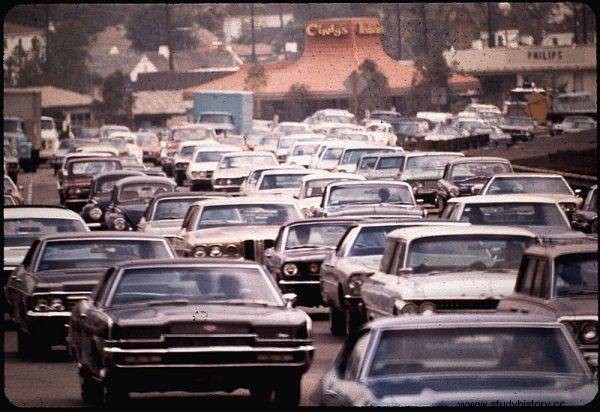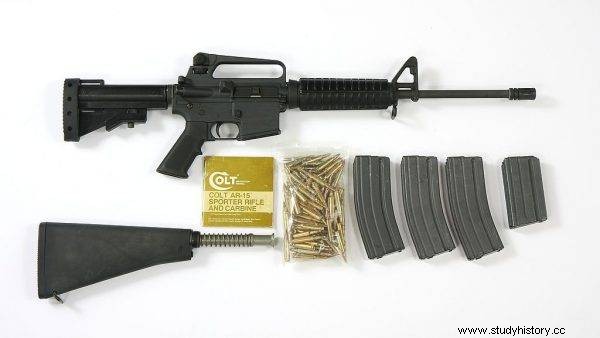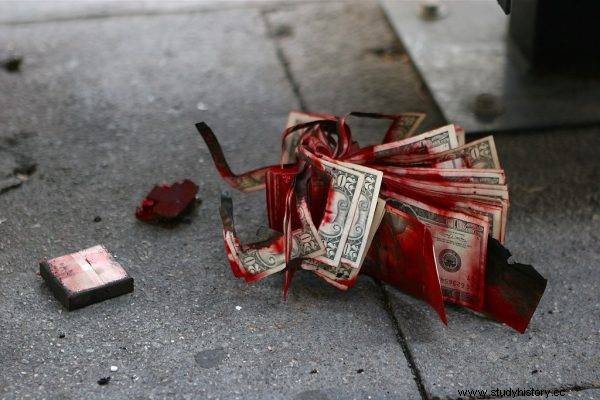$ 20,000 - that's how much was looted by thieves who robbed a bank in Norco in 1980. But it wasn't the stolen sum that made the robbery history.
Every fan of sensational movies knows that one of the best scenes of a bank robbery is the one from the movie "Rush". Even though the scene is praised for its certain amount of realism, with all its panache, most of us will assume that these kinds of events couldn't have happened in the real world. Nothing could be more wrong. Everything related to the Norco robbery could easily be included in a good action movie. The profiles of the bandits and the reasons which led them to robbery are intriguing. The course of the robbery and the shambles between the robbers and the policemen chasing them were shocking. Moreover, this event had far-reaching consequences for the entire US public safety system.
City of Angels
The first association that comes to mind when we think of Los Angeles is Hollywood. In the early 1980s, however, the City of Angels was not just the international capital of film. As it happens, also held the title of the world's bank robbery capital . Over 500 crimes of this type were carried out there during the year, which corresponded to 25 percent. of all bank robberies in the US.

Los Angeles and its environs are wrapped in a dense network of highways. If the robbers could carry out the robbery efficiently enough and get to the expressway before the police arrived, there was no question of catching them.
Californian bandits were above average bank deposits for a very simple reason. Los Angeles and its environs are wrapped in a dense network of highways. If the robbers could manage the robbery efficiently enough to get to the expressway before the police arrived, there was no question of catching them. The ease with which a bank could be robbed was not the only reason why George Smith, 28, was to jump to Security Pacific Bank in Norco . After serving in the military, Smith became a member of one of California's many sects. The common feature of these pseudo-religious movements was the dogma about the imminent end of the world.
Jupiter effect
The teachings of the West Coast religious movements were that Jesus' return would be preceded by Armageddon. According to Smith's calculations, this event was to come in 1981. Smith believed that one had to prepare properly for the end of the world.
At his home on the outskirts of Los Angeles, he began building a shelter, gathering supplies, and stockpiling weapons. His companion and assistant was a colleague from work - Christopher Harven. Due to his emotional instability, Harven was expelled from the military and, like Smith, began to believe various amazing prophecies. For him, the most convincing theory about the end of the world was that associated with the so-called the Jupiter effect. This pseudoscientific rumor was that the conjunction of Jupiter and Pluto would weaken Earth's gravity which will result in catastrophic earthquakes. Armageddon would begin in 1982.

A pseudoscientific rumor was that as a result of the conjunction of Jupiter and Pluto, Earth's gravity would weaken, resulting in catastrophic earthquakes
The common dream of both men was to buy a piece of land in Utah and prepare there for the rest of the world. Unfortunately, the limited financial resources did not allow the implementation of these plans. Smith and Harven agreed to take matters into their own hands and find a way to get cash. After a brief brainstorming session, they figured their financial problems would be resolved by the Security Pacific Bank robbery in Norco.
Firepower
Soon Smith and Harven initiated three more people in their bold plan:Russell Harven, Chris's younger brother, and brothers Manuel and Belisario Delgado. All five put everything on one card. The bank jump became a matter of life and death for them and they intended to prepare as best they could for it.
Smith and Harven, in addition to their tendency to believe in conspiracy theories, had a strong interest in weapons. Even before the thought of organizing the robbery appeared, they gathered a considerable collection of her in the latter's house. After making the decision to rob, they began to rearm, create improvised explosives and devise an attack plan . Soon their arsenal included:Colt AR-15, Heckler &Koch G3, Heckler &Koch HK33, a whole range of various rifles, grenades, Molotov cocktails, thousands of ammunition, and even a katana. The weapons they collected had a firepower far greater than what the rank and file of the American police had at their disposal.

Soon their arsenal included:Colt AR-15, Heckler &Koch G3, Heckler &Koch HK33 and many others
Los Angeles and its outskirts in the 1980s were areas where crime was high. For fear of excessive militarization of the police, the decision was not made to rearm it. Only special units (e.g. S.W.A.T.) had firearms with greater firearms at their disposal. The standard armament of the American policeman at the time was the Smith &Wesson .38 Special revolver and the Remington 870 Wingmaster shotgun. Both types of weapons had a short range and low accuracy. When George Smith's gang raided a bank in Norco on May 9, 1980, US police would eventually realize the weapons were not adapted to the realities of the 1980s.
The Bank Job
The robbery plan was simple. Some time before the robbery, at the other end of the Norco, one of the criminals will fire a small explosive, and the explosion will bring most of the local police units to the area. The rest of the team was tasked with driving up to the bank, bursting in, terrorizing the staff and stealing as much cash as possible within 2 to 3 minutes. By the time the police arrived at the facility, the robbers would have been on their way to Las Vegas.
But nothing went as planned. Choosing the time of the attack turned out to be completely wrong. The bandits were not aware that the bank safes were practically empty on Friday afternoon. The sabotage action literally backfired. The planted explosive was noticed and neutralized. Nevertheless, the leader of the attack, Smith decided to continue the action.
At 3:15 pm, robbers dressed in balaclavas burst into the bank. George Smith, Chris Harven and Manuel Delgado took care of the intimidation of the staff while Russell Harven stood on the lookout. The youngest, 17-year-old Belisario Delgado, was the driver and was waiting for his colleagues in a stolen van. Meanwhile, the robbery was going worse than bad. One of the employees managed to push the silent emergency button and call the police . The second was locked in the vault and cut off the robbers from the rest of the money that was still in the facility. As the hysterical bandits prepared to leave the bank, the first blue and red lights could be seen on the horizon.
Fast and the furious
One policeman shot dead, eight seriously injured, 33 police cars damaged, helicopter shot down. This was the final record of the shooting between the bandits and the policemen. The first policemen who arrived at the scene immediately realized that this was not an ordinary bank jump. From the very beginning they were greeted by heavy machine gun salvos, and the police cars were literally shredded to pieces . Officers were overwhelmed by the firepower that the criminals had at their disposal.

A 17-year-old van driver was dying in an abandoned car. All the cash stolen from the bank was also left there.
The bandits managed to jump into the van and start fleeing the scene of the robbery. One of the policemen, however, managed to shoot at the departing car. The bullet reached the driver, who lost control of the car and crashed the car on a nearby fence. This time the bandits did not lose their cold blood. They stole a yellow Ford F-250 standing nearby and started to flee from the police again. Only four were already driving the car, because the 17-year-old driver of the van was dying in an abandoned car All the cash that was stolen from the bank was also left there. For the next 40 kilometers, the bandits rushed forward at breakneck speed, firing and throwing grenades at police cars. When a police helicopter started circling over the robbers' heads, they shot it down using a sniper rifle.
Hunting bandits
Soon, the pursuit moved from the suburbs of Los Angeles to the mountainous areas surrounding the city. The criminals had attacked one of the police cars there. Policeman James Evans fell into a trap organized by bandits, was shot in the face and died on the spot. The robbers, on the other hand, split up and tried to hide in the surrounding forests on foot. The hunt for bandits has begun.
During the night, more than 60 officers from the S.W.A.T.group were brought to the search area. With such human resources at their disposal, the policemen finally managed to hunt down the criminals. George Smith, Chris Harven and Russell Harven turned themselves over to the police without a fight. Manuel Delgado was the only one who decided to put up an armed resistance. After a short firefight, he was shot dead by the S.W.A.T.
squadArmed to the teeth
The three bandits who survived the manhunt were eventually charged with 46 crimes and then sentenced to life imprisonment without parole. The story of the bank robbery in Norco, however, did not end with the final verdict.
Anyone who followed the riots in the streets of American cities last year may have noticed that even ordinary law enforcement officers looked like members of the anti-terrorist squads . The process of militarization of the police began in the USA after the famous Californian heist. The government administration noticed that with the to the teeth armed bandits the policemen became practically defenseless. After the jump to the bank in Norco, the officers began to be equipped with weapons of much greater firepower.
Forty years after these events in the US, however, a completely different trend is already visible. Police officers who look like soldiers are attracting more and more public interest, which calls for the services to be demilitarized again.
Bibliography:
- Houlahan, Norco '80:The True Story of the Most Spectacular Bank Robbery in American History , Barkeley 2019.
- Schaub, Apocalyptic robbers botched a SoCal bank heist , Los Angeles Times (accessed 10/10/2021).
- Oberhaus, How a 1980 Bank Robbery Sparked the Militarization of America's Police , Vice (accessed 10/10/2021).
